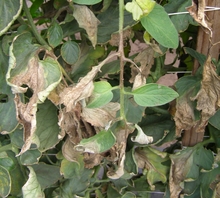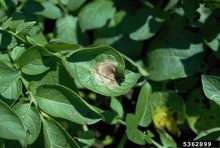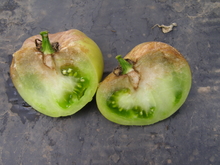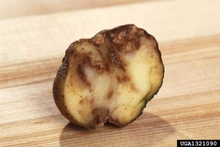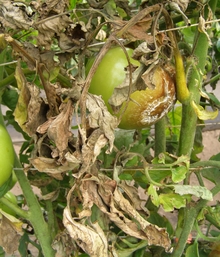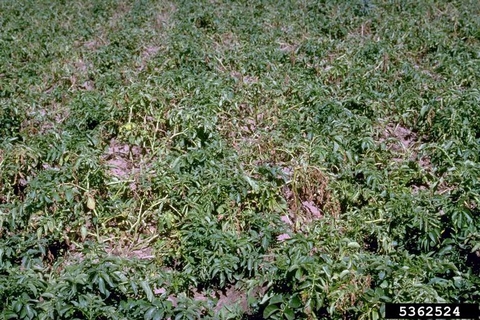Quick facts
- Late blight is a potentially devastating disease of tomato and potato, infecting leaves, stems, tomato fruit, and potato tubers.
- The disease spreads quickly in fields and can result in total crop failure if untreated.
- Late blight does not occur every year in Minnesota.
- Late blight of potato was responsible for the Irish potato famine of the late 1840s.
How to tell late blight apart from other issues
- Leaves have large, dark brown blotches with a green gray edge; not confined by major leaf veins.
- Infections progress through leaflets and petioles, resulting in large sections of dry brown foliage.
- Stem infections are firm and dark brown with a rounded edge.
- In cool, wet weather, entire fields turn brown and wilted as if hit by frost.
- In tomatoes, firm, dark brown, circular spots grow to cover large parts of fruits. Spots may become mushy as secondary bacteria invade.
- In high humidity, thin powdery white fungal growth appears on infected leaves, tomato fruit and stems.
- Infected potato tubers become discolored (anywhere from brown to red to purple), and infected by secondary soft rot bacteria
Biology
- Late blight (Phytophthora infestans) is a water mold.
- Late blight favors cool (60°F to 70°F), damp conditions. Prolonged hot dry days can halt pathogen spread.
- Late blight doesn’t appear in Minnesota every year.
- The most common routes of introduction each season are infected potato seed tubers, infected tomato transplants shipped in from other regions, or windblown sporangia (asexual spores) from the south that then infect fields and circulate locally.
- P. infestans can overwinter in Minnesota if protected in potato cull piles. Overwintering in a tomato production system is unlikely but infected tomato fruits may give rise to infected volunteer seedlings the following season.
- Under cool, wet conditions, P. infestans can infect and produce thousands of sporangia per lesion in less than five days. These sporangia easily become air-borne, resulting in prolific spread of the pathogen.
- There are many different strains of P. infestans. These are called clonal lineages and designated by a number code (i.e. US-23). Many clonal lineages affect both tomato and potato, but some lineages are specific to one host or the other.
- The host range is typically limited to potato and tomato, but hairy nightshade (Solanum physalifolium) is a closely related weed that can readily become infected and may contribute to disease spread. Under ideal conditions, such as a greenhouse, petunia also may become infected.
Managing Late Blight in the Home Garden
- Late blight can be a very damaging disease, so it causes alarm
- Note that late blight is just one of many tomato issues, and isn’t present in Minnesota many growing seasons
- Scout tomatoes regularly and remove diseased leaves
- For a list of more common tomato diseases, see the U of M’s “Quick Guide to Insects and Disease of Tomato.”
There are resistant varieties, though even the varieties will show some late blight symptoms when conditions are highly favorable for disease. Cornell compiles lists of disease resistant vegetable varieties.
- Plant tomatoes where no tomatoes, potatoes, peppers or eggplants have been for the past 3-4 years.
- Keep leaves as dry as possible.
- Water with drip irrigation or a soaker hose.
- Water in the morning so leaves dry quickly in the sun.
- Stake or cage plants.
- Space plants so that air flows between them.
- Remove or bury plants at the end of the season. Manage cull piles so culls break down over winter.
Late blight isn’t often seen in Minnesota gardens, and pesticides sprays are not recommended in the home garden.
Managing Late Blight on Farms
Growers should watch for late blight symptoms in their regular scouting, particularly with weather conditions that favor disease. Detecting late blight early is important. Scout early in the day before dew dries, and pay extra attention to portions of the field that may dry out more slowly (areas shaded by trees, areas with poor air circulation, etc.)
If you suspect you have late blight, reach out to the University of Minnesota Fruit and Vegetable team, as late blight is an important region wide issue and neighboring crops are at risk.
Reports of regional outbreaks of late blight can be found at the USAblight website. Subscribe to the U of M Fruit and Vegetable News to receive updates on late blight and other vegetable diseases in Minnesota.
- Destroy potato cull piles before the growing season begins by burying them, spreading and incorporating them into fields, or, in the case of potatoes, feeding them to livestock.
- Control volunteer potato plants, as infected plants can grow from infected tubers.
- Seed infection is unlikely on commercially prepared tomato seed or on saved seed that has been thoroughly dried.
- Plant certified potato seed.
- Inspect tomato transplants for late blight symptoms prior to purchase and/or planting, as tomato transplants shipped from southern regions may be infected.
- If infection is found in only a few plants within a field, infected plants should be removed, disced-under, killed with herbicide or flame-killed to avoid spreading through the entire field.
Even a resistant variety will show some late blight symptoms when conditions are highly favorable for disease. Levels of resistance vary between cultivars and may be more or less effective depending on the P. infestans clonal lineage present. Cornell compiles lists of disease resistant vegetable varieties.
- Products are available for management of late blight on tomatoes and potatoes. Fungicide applications should be made prior to infection when environmental conditions favor disease to be the most effective.
- Phytophthora infestans is a water mold and not a true fungus. Fungicides specific to water molds must be used and applications repeated according to label instructions.
- For a current list of fungicides for late blight management visit the Midwest Vegetable Production Guide. Rotate fungicide groups and/or tank mix fungicides to avoid producing fungicide-resistant isolates.
CAUTION: Mention of a pesticide or use of a pesticide label is for educational purposes only. Always follow the pesticide label directions attached to the pesticide container you are using. Be sure that the plant you wish to treat is listed on the label of the pesticide you intend to use. And observe the number of days between pesticide application and when you can harvest your crop. Remember, the label is the law.
Reviewed in 2021


